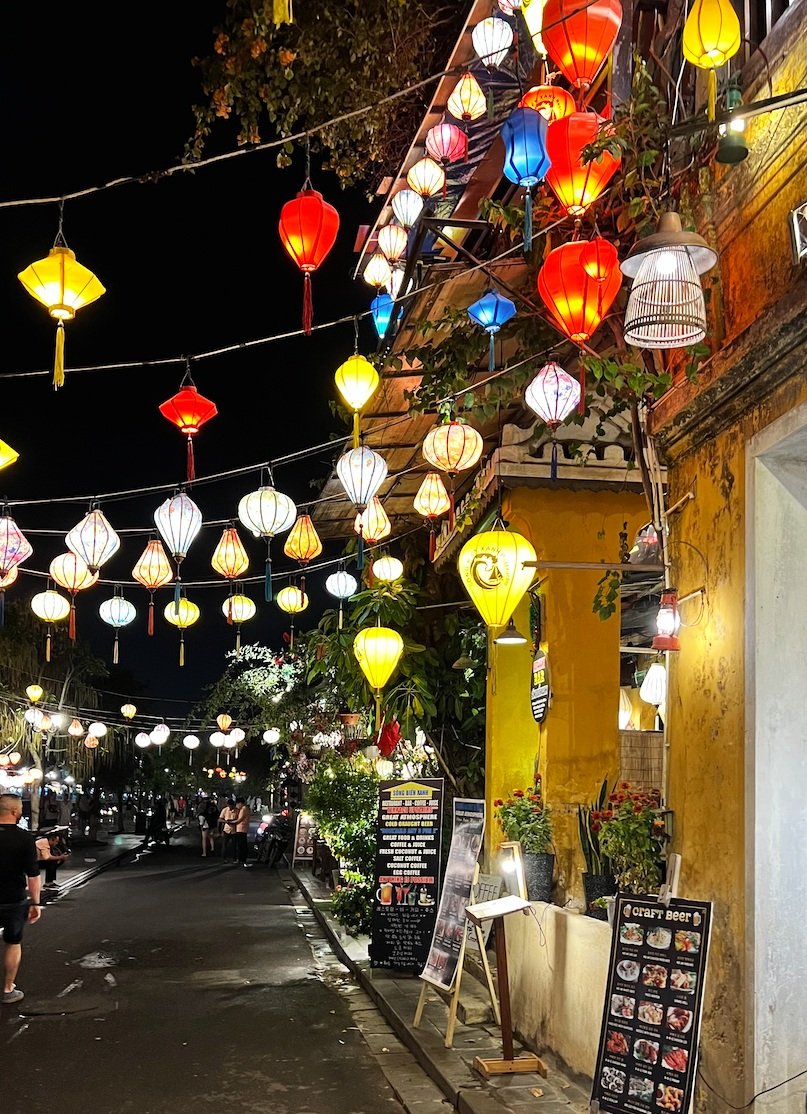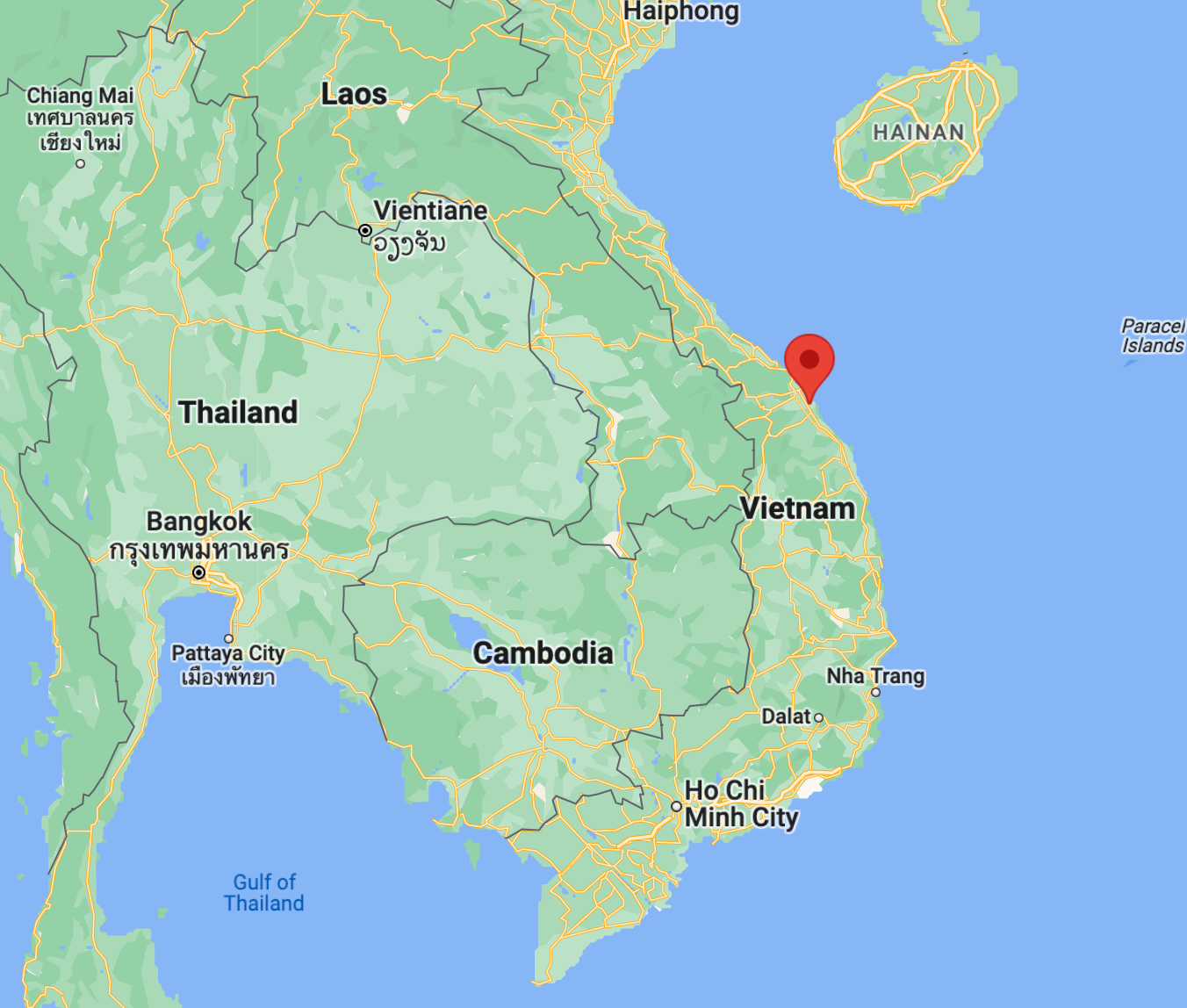Looking for a travel guide to Hoi An? You’re in the right place!
I’ll be honest: Vietnam was never any where near the top of my travel bucket list, but now it’s one of my favorite countries (and one I can’t wait to go back to, especially after this trip to its south France-esq countryside)! Hoi an has a beautiful, laid back vibe, and its green, flowery country side is bursting with flavors, sights, and culture!
It’s a lively ancient village nestled on the banks of the Thu Bon River in central Vietnam. Quaint and charming, Hoi An rises out of the mist of miles of bright green rice fields, wildflowers, and waterways with bread & breakfasts, little markets, and farm to table restaurants.
If you walk or take a bike into the ancient town, you’ll find more bustle— music, street food, and cobblestone alleyways sparkling with colorful lanterns floating down a quiet river lined with leafy palms.
While it’s small and walkable, Hoi An is also a UNESCO World Heritage site that offers a unique glimpse into Vietnam’s past with enchanting floating lanterns, gently lit alleyways, vibrant markets, interesting eats, and a cozy feeling with the allure of a a river that carries whispers of the past.
Vietnam is so far away (and was so foreign to me) that planning the trip was a little overwhelming. So here’s the best-of-the-best in Hoi An— all of the guesswork removed and your questions answered in one travel guide to Hoi An.
Hoi An, Vietnam Travel Guide
Where is Hoi An?
Hoi An is located in central Vietnam in the Quang Nam Province along the Thu Bon River. It sits on Vietnam’s coastal waterways and is ~30 kilometers south of Da Nang.
What is Hoi An famous for?
Hoi An is famous for its well-preserved Ancient Town, which is a UNESCO World Heritage site. The town has beautiful fusion architecture, lantern-lit streets, and rich cultural heritage.
Stroll along the atmospheric lanes adorned with colorful lanterns and marvel at the historic buildings that blend Chinese, Japanese, and European influences. Hoi An is also world-renowned for its tailoring services and silk, where you can have custom-made clothing created in a short amount of time at a really cheap price for Western tourists.
What are some unique things to do in Hoi An?
Other than exploring the Ancient Town, some must-do things and attractions in Hoi An include:
-
Taking a lantern boat ride on the Thu Bon river at night
-
Bike riding through the bright green rice fields and waterways
-
Eating street food on the river street, which is really lively at night!
-
Japanese Covered Bridge
-
Assembly Halls of Chinese communities
-
Tan Ky House
-
Hoi An Museum of History and Culture
Are there any famous local dishes in Hoi An?
Some must-try dishes in Hoi An include Cao Lau (a noodle dish with pork and herbs), White Rose (a type of dumpling), Banh Mi (Vietnamese baguette sandwich), and Mi Quang (a noodle dish with shrimp, pork, and herbs). I also enjoyed eating banana crepes and trying the local beers while exploring the night market.
How long do you need in Hoi An?
Plan to spend at least 2 to 3 days in Hoi An to fully explore the everything it has to offer.
This will give you enough time to visit the Ancient Town, take a bicycle ride through the countryside, visit nearby beaches, and enjoy the markets. Hoi An was hard to leave and I wish I’d taken 5-7 days there to fully relax into its unique ambiance and explore it on a deeper level.
Are there any beaches in Hoi An?
Yes, Hoi An is located close to several beautiful beaches! The most popular ones are An Bang Beach and Cua Dai Beach. These beaches have golden sand, clear water, and cute beachside restaurants and water sports. You can unwind in the idyllic coastal scenery, enjoy a beachside massage, or indulge in fresh seafood delicacies at one of the charming beachfront eateries.
How to get to Hoi An
The nearest airport to Hoi An is Da Nang International Airport, which is well-connected to major cities in Vietnam and other international destinations. From the airport, you can take a taxi or arrange for a private transfer to Hoi An, which is a 45-minute drive away.
You can also take a train or bus from other cities in Vietnam (we took the train from Ho Chi Minh to Da Nang and a taxi to Hoi An from there).
When is the best time to visit Hoi An?
The best time to visit Hoi An is during the months of February to May when the weather is generally pleasant, with mild temperatures and low humidity.
Avoid the rainy season from September to January, not just because of the rain, but because this is when mosquitos come out with a vengeance.
How do you get around in Hoi An?
Yes, Hoi An’s Ancient Town is pedestrian-friendly and best explored on foot. The town is relatively small, and its narrow streets are closed to traffic during certain hours, allowing visitors to leisurely stroll and admire the architecture, visit shops, and enjoy the local atmosphere.
Is Hoi An worth visiting?
I see a lot of people trying to decide between Hoi An vs. Da Nang, but HANDS DOWN Hoi An was my favorite city in Vietnam. Da Nang is just another city (with a very cool dragon bridge, yes) but it doesn’t compare to the charm and uniqueness of Hoi An.
This blog may contain affiliate links, which means that at no cost to you, I may earn a small commission of any products sold. I only feature products that I believe in and use. Your support means the world to me and allows me to host this website!






LEAVE A COMMENT